TechRadar Verdict
The UE49KS8000 continues Samsung's dedicated pursuit of the ultimate HDR experience with its high brightness and powerful colour technologies. There are one or two stumbles along the way, but overall no other TV around today offers the same level of HDR excitement for so little cash.
Pros
- +
Strong design
- +
Genuine HDR experience
- +
Good value
- +
Outstanding SDR picture quality
Cons
- -
Some HDR backlight issues
- -
Colour striping with HDR
- -
No 3D support
- -
Some missing apps
Why you can trust TechRadar
The UE49KS8000 has three big attractions to its name. First, it's one of Samsung's so-called SUHD TVs. This means it combines a super-bright LCD panel with a local dimming system for the backlight plus wide colour spectrum capabilities built on a proprietary version of Quantum Dot technology.
Second, it's a flat TV rather than a curved one. This makes it a relative rarity in Samsung's SUHD range, yet for many AV fans flat remains very much where it's at.
Finally, for a TV that offers so many cutting edge features and so much 'next-generation' potential, the UE49KS8000's £1300 price tag looks like it could represent great value. Provided the TV lives up to its on-paper promise, of course.
Design
Samsung has sensibly stepped away from the aggressively stylised but chunky look of many of its 2015 TVs in favour of the sort of slimmer, more minimalist looks that have served it so well in years gone by.
The narrowness of the screen frame is echoed by a slender rear that stands in stark and, for me, welcome contrast to the quite chunky depth created by Samsung's curved TVs. In fact, with its 1094 x 636 x 43mm (W x H x D) dimensions, the UE49KS8000 lends itself much more naturally to wall hanging than any of Samsung's curved models.
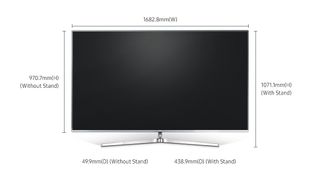
The addition of a gleaming metallic trim to the outer edge of the UE49KS8000's screen frame gives the set a really high-end feel that's sealed by a nifty curved single-bar foot mount finished in polished aluminium.
I did notice while setting the TV up that its build quality isn't as imposing as that of Samsung's more expensive 2016 TVs. There's a rather plasticky feel to the non-metal bits. Still, most normal people don't stroke their TV once it's installed, and from a typical viewing distance the set certainly looks reassuringly expensive.
The UE49KS8000's connectivity is strong too, thanks to its highlights of four HDMIs, three USBs, and the usual choice of either wired or Wi-Fi network connectivity. The only major connection disappointment is the lack of a normal headphone port; the only way to use headphones with this TV is via Bluetooth.
Screen sizes available: 49-inch, 55-inch, 65-inch, 75-inch | Tuner: Freeview HD | 4K: Yes | HDR: Yes (HDR10) | Panel technology: LCD with edge LED lighting | Smart TV: Yes, Tizen | Curved: No | Dimensions: 1094 x 636 x 43mm (W x H x D) | 3D: No | Inputs: Four HDMIs, three USBs, optical digital audio output, Wi-Fi, Ethernet port, Tuner input
Design TL;DR: The UE49KS8000 is one of the prettiest TVs around this year - so long as you're not bothered by the fact that it isn't curved.
Smart TV – Tizen
Samsung's latest Tizen-based Smart TVs make it much easier than their predecessors did to get quickly to interesting or favourite content.
Calling up the home screen still initially presents you with the same single row of icons along the bottom of your screen you got with 2015's Samsung smart TVs, showing your most recently used and favourite apps. Highlight one of the icons, though, and you'll now see a secondary contextual 'deck' of icons appear above the main one that changes depending on the icon you've selected from the lower deck.
There's really no overstating how much slicker this simple change makes the process of navigating through all the UE49KS8000's myriad content options.
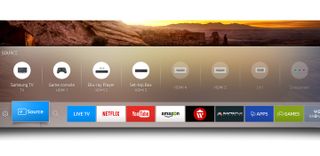
Your less-used downloaded apps and Samsung's online app 'store' can be accessed via a simple selectable box on the left of the home screen, and you can easily customise the home screen to ensure it always contains your favourite apps.
Available apps are headlined by 4K and HDR versions of Amazon and Netflix; YouTube; Playstation Now; the BBC iPlayer; and the ITV Hub. At the time of writing neither the All4 or My5 catch up services were available, though, making me wish Samsung would join the other main UK TV brands in offering a third-party 'catch up' solution such as Freetime, Freeview Play or YouView.
Smart TV TL;DR: Samsung's 2nd-gen Tizen interface is a considerable improvement on 2015's build - though it would be helpful if Samsung provided a more comprehensive catch-up TV solution.
HD/SDR Performance
With the standard dynamic range content that still occupies the majority of our viewing time, the UE49KS8000 is an exceptional performer for its money.
At the heart of its SDR thrills is a superb black level response by edge-lit LCD TV standards. Dark scenes benefit from black colours that actually look black - especially if you use the local dimming system that lets different segments of the TV's edge-mounted LEDs deliver different amounts of light to suit the image content.
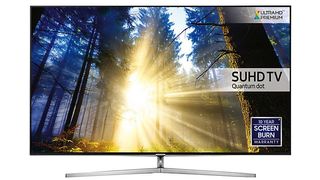
What's more, in SDR mode this localised LED control expands the TV's contrast range while suffering hardly any unwanted light pollution around bright objects, even when those bright objects appear against near-black backdrops. This is a very rare accomplishment in the edge LED world.
Having such deep blacks to play off also helps the UE49KS8000's SDR colours look impressively vivid and accurate.
It's important to stress, too, that the excellent black levels aren't achieved at the expense of shadow detailing. In fact, dark scenes contain so much subtle detailing and colour information that they enjoy a sense of depth that's pretty much on a par with bright scenes, making for a much more consistent viewing experience than you commonly get with edge LED TVs.
The vividness of the UE49KS8000's colours, meanwhile, is joined by some gorgeously subtle colour toning, which helps to emphasise the clarity of what can fairly be described as one of the sharpest, most detailed UHD images I've seen in 2016.
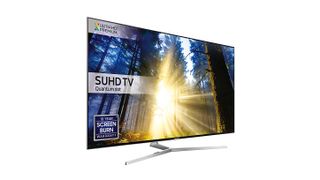
While the UE49KS8000 is inevitably at its best with native UHD sources, it's certainly no slouch at upscaling HD sources. Blu-rays and HD broadcasts enjoy a clear boost in sharpness while simultaneously having the vast majority of any source noise they may have contained magically removed.
The only word of caution here is that you shouldn't set the TV's sharpness higher than around 25 with upscaled HD, otherwise areas of fine detail or very defined edges can start to 'glow' quite distractingly.
HD/SDR Performance TL;DR: I can't think of another TV at the UE49KS8000's price point that's capable of delivering a better picture with HD and SDR sources.
4K/HDR Performance
While the UE49KS8000 is a great SDR performer, it's with HDR that it most makes its mark against the competition.
The first point to make about the UE49KS8000's HDR performance is that it's the proud owner of an Ultra HD Premium badge. This means that its UHD screen is capable of delivering the 1000-nit peak brightness, 0.05 nit black levels and 90%+ of the cinema world's DCI-P3 colour spectrum requirements defined by the AV industry's Ultra HD Alliance as being key to a 'proper' HDR experience.
These specifications translate on the UE49KS8000 into superbly bold, dynamic HDR pictures that get much closer to unlocking the format's full potential than any other sub-£1500 TV.
Particularly effective is the way the UE49KS8000 can hit brightness peaks above the 1000 nit level used in the mastering of a healthy chunk of the current HDR sources out there. As well as instantly 'selling' the impact of HDR versus SDR, this brightness helps Samsung's TV resolve subtle tonal detailing in the brightest areas that tends to 'flare out' on less bright TVs.
It should be said that the UE49KS8000 can't hold on to its highest brightness levels for more than a few seconds, whereas Panasonic's HDR TVs are able to maintain their (lower) peak brightness levels for much longer. However, there isn't currently much 'real world' content out there that requires a TV to hold on to large areas of extreme brightness for a length of time that should cause the UE49KS8000 problems.
The UE49KS8000 also does a stellar job of delivering the wide colour ranges that are part of the Ultra HD Blu-ray HDR experience. Whether it's the insanely red trees at the start of Star Trek: Into Darkness or the lush animated tones of The Peanuts Movie, wide colour gamut content always looks fantastically punchy and dynamic. The richness of the colours holds up during dark scenes better than usual with LCD TVs too.

The UE49KS8000 isn't only good at showing off the most dynamic aspects of HDR and wide colour gamut sources, though. It's also got enough finesse in its HDR toning to handle less explosive image areas like skin and cloudy skies with real sensitivity and naturalism.
As noted when watching standard dynamic range content, the huge range of colour tones available to the UE49KS8000 in HDR mode joins forces with the native UHD resolution to deliver superbly detailed images.
The only detractor from the KS8000's mostly stellar clarity is some fairly pronounced motion judder when showing 4K content. You can tackle this with the TV's motion processing, but since the judder is quite severe the motion processing has to work harder than it ideally would, thus causing a few distracting digital side effects.
I should point out, too, that the UE49KS8000's 49-inch screen doesn't deliver as much impact from its native UHD resolution as bigger screens would - though you can still see some difference from a fairly typical viewing distance.
The UE49KS8000's biggest picture 4K/HDR flaw involves its backlight. HDR's much more extreme brightness range means that sometimes when the TV is required to show a bright HDR image against a dark HDR background you can clearly see vertical bands of light running down the image, as the edge LED lighting system tries to get sufficient light to the bright object.
Whenever this happens you're aware that you're watching the TV's technology at work, reducing your sense of immersion in the onscreen action.
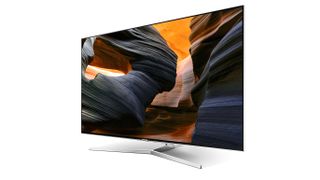
The problem disappears if you turn off the local dimming, but I wouldn't recommend this as it reduces both the excellent black level performance and the intensity of HDR's brightness peaks.
To be fair, the light bar issue is not very aggressive so long as you stick with the low setting of the local dimming system. The problem is much less noticeable, too, if the room you're watching TV in is quite bright, and it's also true that you only see the offending light bars during quite dark HDR scenes.
If you're the sort of person who likes to dim the lights for serious film-viewing sessions from time to time, though, will certainly see the light banding at least a few times during pretty much any film.
4K/HDR Performance TL;DR: Despite being smaller than I usually like my UHD TVs, the UE49KS8000 delivers the most spectacular HDR UHD images I've seen at its price point.
Sound
Despite its enviably trim bodywork, the UE49KS8000 produces a pretty potent audio performance. It can hit movie-friendly volume levels without the speakers distorting or dropping out, and packs its treble range with plenty of subtle detailing and effect placement. Voices sound clear and authentic, the soundstage spreads beyond the physical confines of the TV's chassis without becoming incoherent, and the speakers open up to accommodate action movie sequences without starting to sound brittle and thin.
In a perfect world there'd be more bass to flesh out explosions, gun fire and the like. But perfect sound and very thin TVs seldom go together, and by the standards of thin TVs generally the UE49KS8000's audio is well above average.
Sound quality TL;DR: The UE49KS8000 sounds much more powerful and detailed than its skinny chassis would lead you to expect.
Other panels to ponder
There aren't any other TVs at the UE49KS8000's price point that can match the dynamics of its HDR performance. The Panasonic TX-58DX750, though, gives you a more subdued but still impressive all-round 4K HDR picture in a much bigger 58-inch screen for just £1,149.
If you'd like one of Samsung's curved TVs rather than the UE49KS8000's flat screen, I'd recommend finding a couple of hundred pounds more for the bigger 55-inch UE55KS7500.
One final alternative would be the Panasonic TX-DX802 series. These 4K HDR TVs are widely available for under £1,100, and stand out from the crowd thanks to its external sound bar audio system and a unique design which sees its 50-inch screen hanging between two easel-style legs. The 50DX802's picture and sound quality are both strong, though it doesn't deliver quite such extreme HDR images as the UE49KS8000 and also joins Samsung's set in exhibiting a few backlight issues.
Verdict
The UE49KS8000 is a class act for its money. It sets the right tone as soon as you get it out of the box with a trim, glamorous design, and swiftly builds on that with its killer combi of a Tizen-driven smart TV system, a native UHD resolution and high dynamic range playback.
It's even managed to secure the AV industry's Ultra HD Premium seal of approval, meaning it hits the contrast, colour, resolution and brightness specifications recommended for a full-blooded HDR experience.
Its pictures deliver on this HDR potential with levels of brightness and colour you just don't get anywhere else for the same sort of money - though it's a star with standard dynamic range footage too.
There is a price to pay for such dynamic pictures in the appearance of some backlight clouding flaws during dark HDR scenes, but in the end the pros far outweigh the cons.
John has been writing about home entertainment technology for more than two decades - an especially impressive feat considering he still claims to only be 35 years old (yeah, right). In that time he’s reviewed hundreds if not thousands of TVs, projectors and speakers, and spent frankly far too long sitting by himself in a dark room.


